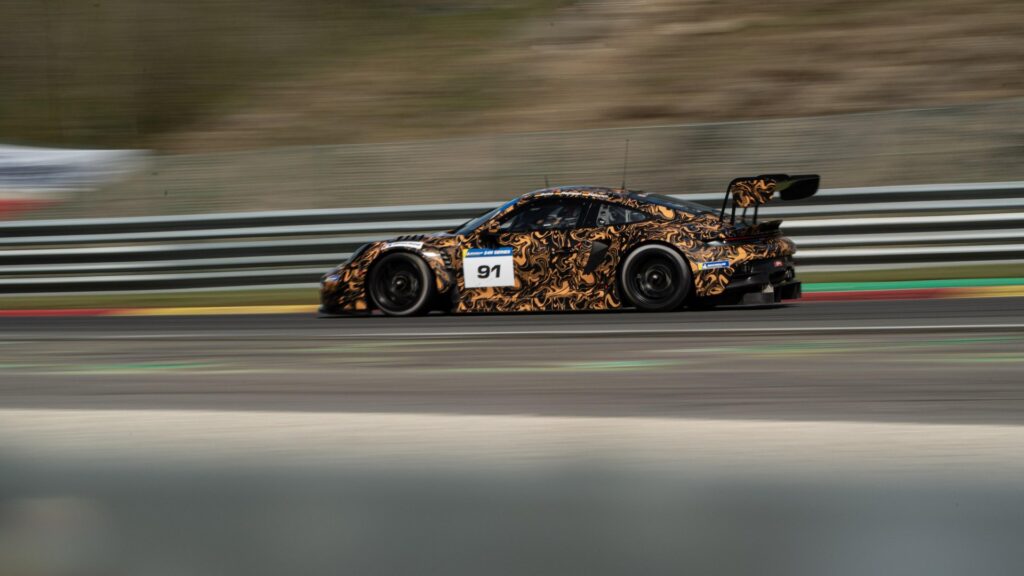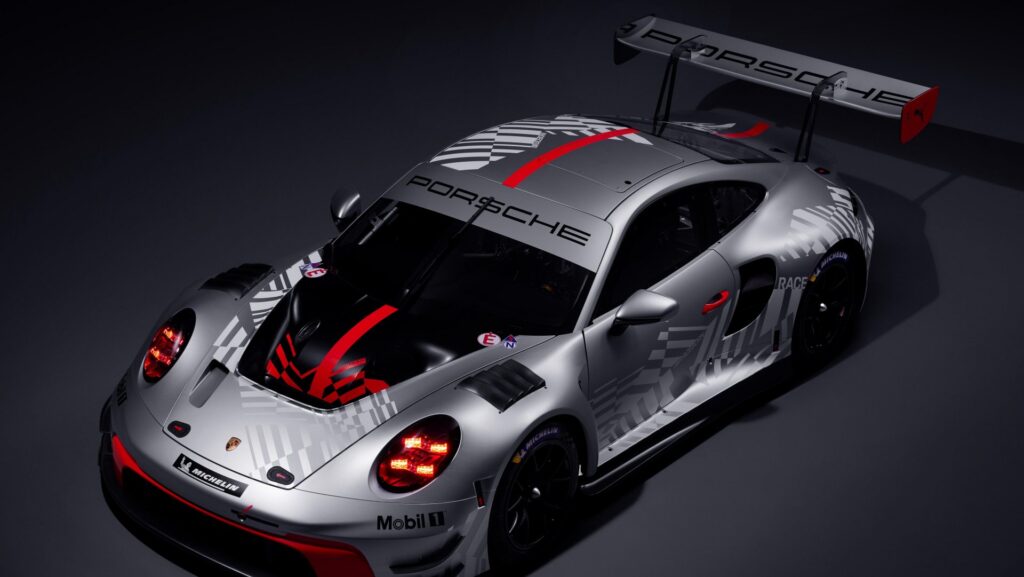Porsche has unveiled two updated 911 race cars based on the latest 992.2 platform, the 911 GT3 R and a new Cup variant.
“Our focus for this update was on optimization. Small changes can make a big difference when built on a solid, proven foundation,” said Sebastian Golz, project manager for the 911 GT3 R. “Driver feedback after the first race outing during the development phase in April confirmed our direction. We’re confident this evolution will allow our customer teams to continue competing successfully across the globe.”
Updates have centered around refining the aerodynamic and chassis packages. The car now features louvres atop the front wheel arches, which, coupled with revised kinematics on the front suspension, help reduce front end dive under braking and maintain aero balance. As a result, Porsche states that new 911 GT3 R offers more precise and predictable braking behavior, improving overall control. 
At the rear, the swan-neck rear wing is equipped with a 4mm Gurney flap which generates additional aerodynamic downforce and broadens the scope for aerodynamic balance adjustments. The underbody is fully enclosed and reinforced at the rear and modified kinematics of the multi-link rear axle increase the anti-squat effect, reducing rear-end compression under hard acceleration. This improves dynamic load distribution between the axles. In combination with an adapted fifth-generation ABS system from Bosch, these enhancements result in more balanced handling, Porsche says.
Further detailed improvements are based on the extensive feedback from Porsche Motorsport’s customer teams across a wide range of racing events worldwide. For instance, the electrohydraulic power steering system now features additional fluid cooling, optimizing its thermal performance and ensuring consistent steering forces, even on demanding circuits such as the Nürburgring Nordschleife.
New ceramic wheel bearings enhance robustness and durability, while modified centring pins simplify the installation of drive shafts. These are now cooled directly via their own air supply through NACA ducts in the side skirts, independent of the brake cooling. This improves their stability on high-speed tracks such as Monza or Le Castellet, where low ride height is critical. At the same time, the rear brake cooling system can be adjusted more precisely – an important feature for circuits like Daytona. 
A modified driver air vent ensures consistent air circulation within the cockpit, even during long-distance races. The remote logger unit now offers practical advantages: this RLU stores the driving data of the new 911 GT3 R directly on a USB stick, which can be quickly swapped out – even during a short pit stop – eliminating the time-consuming need to connect a laptop via cable.
Option packages are now included as standard equipment
Porsche now offers several former non-standard optional packages for the new 911 GT3 R ex-works: the sensor package, endurance package, pit lane link package and camera package. These kits include four laser ride-height sensors, two master brake cylinder potentiometers, a track temperature sensor, a rear-view camera and mountings for the water bottle system.
A refueling detection sensor registers when the fuel nozzle is inserted. Together with an additional refueling LED, this plays a key role in series such as IMSA and the FIA World Endurance Championship, as well as in the 24 Hours of Spa-Francorchamps, to ensure compliance with minimum refueling times and energy quantities.
Customer teams can still choose from a range of special equipment options that are tailored to the demands of specific GT3 series. For the FIA LMGT3 class and IMSA, these include special driveshafts; and in the NLS, a modified pre-silencer similar to the LMGT3, as well as wing supports with a modified adjustment range, are offered.
Update path
The 4.2-liter flat-six engine, which delivers up to 416kW (565ps) depending on its balance of performance (BoP) classification, and the drivetrain of the current 911 GT3 R remain largely unchanged. For existing vehicles based on the 992-generation 911, Porsche Motorsport plans to offer around 60 update kits at a unit price starting at €41,500 (US$48,300) plus country-specific sales tax. The new-generation modifications can then be installed on existing vehicles.
Development of the new 911 GT3 R began in August 2024. Porsche Motorsport conducted testing both at its in-house facility in Weissach and on permanent race circuits such as Sebring, Paul Ricard, Spa-Francorchamps and the Nürburgring Nordschleife.
A key test took place in mid-April under competitive conditions, when a test vehicle entered by Herberth Motorsport competed in the Michelin 12H Spa-Francorchamps on the Belgian Grand Prix circuit. Former Porsche Junior and reigning IMSA GTD Pro champion Laurin Heinrich, along with his German compatriots Ralf Bohn and Alfred Renauer, secured second place overall in the two-part race.
Porsche Motorsport will offer the next-generation 911 GT3 R to customer teams at a price of €573,000 (US$666,899), excluding country-specific VAT and optional extras.
Cup car updates
“Like its successful predecessors, the new 911 Cup pushes boundaries. It combines series components from our GT sports cars with pure racing technology to create a coherent and performance-based overall concept,” noted Thomas Laudenbach, VP of Porsche Motorsport.
“Driving the 911 Cup has always been regarded as a challenge, and we want to keep it that way because it also serves as the training platform for our Porsche Juniors. The success of this concept is evident in its countless race and championship victories.” 
The 911 Cup is largely derived from the road-approved 911 GT models and is produced alongside the series-production cars at Porsche’s main plant in Zuffenhausen. This has proven highly successful: since production began at the end of 2020, Porsche Motorsport has built 1,130 units of the current 911 GT3 Cup. To date, a total of 5,381 Porsche 911 vehicles have been produced as one-make racing cars.
The front end of the Cup car now reflects the design of the 992.2-generation 911 GT3. The front spoiler lip is now made up of three separate parts, enabling the damaged sections to be replaced after contact, which also helps lower packaging and shipping costs for spare parts. The removal of the daytime running lights serves a similar purpose: in the event of a collision, they can no longer damage the radiators behind them, nor do they require replacement afterward.
The fenders feature integrated louvre vents, which aid airflow through the wheel arches and enhance aerodynamic downforce on the front axle. The same effect is achieved by the aerodynamically optimized underbody, which – like in the standard model – positively influences the car’s driving dynamics.
So-called turning vanes, located behind the front wheel arches, further improve airflow along the front end. The interaction of these elements results in a more responsive front axle, particularly at high speeds, enabling the driver to position the race car with greater precision ahead of each corner.
The more aggressively styled rear end of the new 911 Cup has undergone a complete redesign. The swan-neck rear wing features a revised connection to the wing supports, making position adjustment and handling easier. The engine compartment cover has also been thoroughly reworked. Like almost all body components – including the doors – it is made from recycled carbon fiber fleece combined with bio-based epoxy resin. For example, off-cuts from other manufacturing processes are repurposed to produce the fleece, a measure that contributes, among other benefits, to stabilizing spare parts pricing.
Power increase
The 4.0-liter flat-six now delivers 382kW (520ps) and incorporates additional components from the series production engine, including flow-optimized individual throttle valves and camshafts with extended valve opening times. This design eliminates the need for a centrally positioned throttle valve, which in turn allows for the installation of an air restrictor – a requirement for competing in many series outside of the various Carrera Cups.
Despite a 10ps power increase, the engine’s service life remains unchanged: it only requires an overhaul after 100 hours of track time. To comply with varying noise regulations depending on the racing series, circuit and local regulations, three different exhaust systems are available.
A more robust four-disc sintered metal racing clutch now handles power transmission to the sequential 6-speed dog gearbox. This upgrade enables the engine speed, previously limited to 6,500rpm during a standing start, to be increased, further enhancing the acoustic theatrics at the beginning of a race.
An automatic engine restart function has also been introduced. This activates as soon as the driver depresses the clutch pedal after an accidental stall. Additionally, a new stroboscope function on the brake lights now alerts following drivers, particularly during the start phase. This replaces the previous use of the hazard warning lights for this safety application.
Porsche is offering the new Cup car for €269,000 (US$313,000), excluding country-specific VAT.
In related news, GM has revealed the second in a series of three Chevrolet Corvette concept design studies to debut in 2025. The California Corvette concept, a one-of-one hypercar, blends “racing-simulator inspiration with iconic Corvette cues”, the auto maker said. Read the full story



